GP39
| SITE: GP39. | Property: M Groves |
| Location: Hedley | Aust. Soil Class.: Humose-Acidic, Eutrophic, Grey DERMOSOL : Humose-Acidic, Dermosolic, Redoxic HYDROSOL |
| General Landscape Description: Level plain (1% slope). Original vegetation included Swamp Gum (Eucalyptus ovata), Melaleuca (Melaleuca ericifolia) and Casuarina (Allocasuarina spp). | |
| Site Description: Grazing paddock. | Geology: Pleistocene alluvial deposits. |
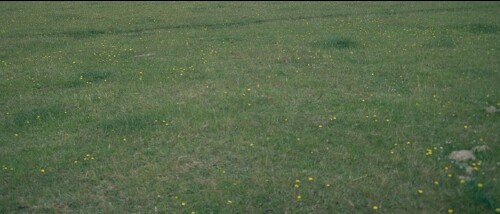
GP39 Landscape
Soil Profile Morphology:
Surface Soil
| A1 | 0-15 cm | Very dark greyish brown (10YR3/2); light fine sandy clay loam; hardsetting surface condition; moderate coarse polyhedral, parting to moderate fine polyhedral structure; very firm consistence dry; some compaction below 5 cm; pH 5.3; clear change to: |  GP39 Profile |
| A2 | 15-30 cm | Sporadically bleached (10YR5/2d) in patches; rusty root channel mottling; light fine sandy clay loam; moderate coarse subangular blocky, parting to moderate subangular blocky structure; very firm consistence dry; pH 5.6; clear and wavy change to: | |
| Subsoil | |||
| B21 | 30-60 cm | Greyish brown (10YR5/2) with strong brown (7.5YR4/6) mottles associated with root channels, minor sporadic bleach; light clay (fine sandy); moderate coarse, parting to moderate blocky structure; contains few (2-5%) quartz fragments; very firm consistence dry; pH 5.6; gradual and wavy change to: | |
| B22 | 60-90 cm | Light brownish grey (10YR6/2) with brownish yellow (10YR6/8) mottles; light medium clay; moderate coarse prismatic, parting to moderate coarse subangular blocky structure; very firm consistence moist; pH 5.3: | |
| B23 | 90-150cm | Light brownish grey (10YR6/2) with yellow (10YR7/8) mottles; medium clay (fine sandy); strong coarse prismatic, parting to moderate coarse angular blocky, parting to moderate prismatic structure; very firm consistence moist; contains very few (<1%) quartz crystals; pH 5.4: | |
| B24 | 150+ cm | Grey (10YR6/1) with yellow (10YR7/8) mottles; heavy clay (fine sandy). | |
Key Profile Features:
- Lack of strong texture contrast between surface (A) horizons and subsoil (B) horizons.
- Seasonal saturation (for a few months each year) of much of the soil profile.
- Sporadically bleached A2 horizon.
pH | Salinity Rating | |||
Surface (A1 horizon) | Strongly Acid | Low | Non-Sodic | None |
Subsoil (B21 horizon) | Moderately Acid | Low | Sodic | None1 |
Deeper subsoil (at 1 m) | Strongly Acid | High | Sodic | __ |
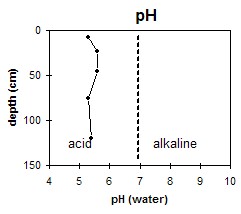 The surface soil is strongly acid. The subsoil is moderately acid, becoming strongly acid at 1 metre. | 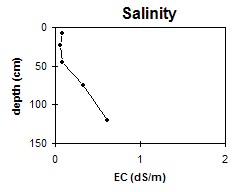 In the surface and upper subsoil the salinity rating is low. At 1 m depth the levels of soluble salt becomes high. | 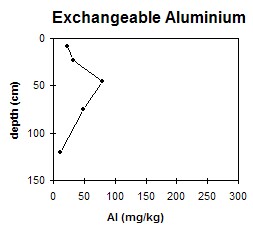 The exchangeable aluminium levels are relatively low for the surface soil. They become moderate in the upper subsoil and then decrease. | 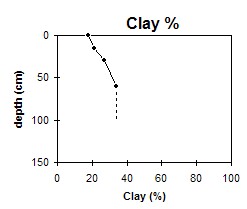 The clay content gradually increases with depth down the profile. |
Whole Profile
- Much of the soil profile is strongly acid. As a result, deficiencies in molybdenum, potassium and phosphorus may occur. Manganese toxicity may also occur in strongly acid soils, particularly when poorly drained (as waterlogging may bring manganese into solution). Soils in these low lying positions are likely to suffer from seasonal waterlogging (as evident by the native vegetation ie. swamp paperbark and swamp gum).
- Plant available water capacity (PAWC) is considered to be low (estimated at 75 mm) for the top metre of the soil profile. This is based on available laboratory data. A significant proportion (?? mm) of the plant available water is held in the surface (A) horizons. Effective PAWC is likely to be lower than this due to the coarsely structured subsoil. Seasonal saturation of the profile will also restrict root growth.
- The surface (A1) horizon is strongly acid. Levels of exchangeable aluminium measured are not high (ie. 23 mg/kg). A pH/aluminium test sampled across the paddock would be most appropriate to determine whether lime is needed to raise soil pH. However, other factors need to be considered before lime is recommended (eg. pasture species grown, method of application, local trial responses, soil surface structure and likely cost/benefit).
- The inherent fertility of the surface (A1) horizon (based on the sum of the exchangeable calcium, magnesium and potassium cations) is relatively low. The high levels of organic matter at this site are important for improving soil fertility, water holding capacity and enhancing surface soil structure; especially with the high fine sand content of the surface soil (39%).
- Deficiencies in molybdenum and phosphorus are likely to occur in strongly acid soils. If lime is required, an application may assist in alleviating molybdenum deficiency and will increase phosphorus availability, as well as increasing soil pH. Phosphorus tends to become 'fixed' by high levels of exchangeable aluminium.
- The subsurface (A2) horizon disperses completely after remoulding. This indicates that disturbance (eg. by tillage) to this horizon whilst in a moist to wet condition may result in structural degradation (eg. ploughpan development).
- The presence of a sporadic bleach within the subsurface (A2) horizon indicates periodic waterlogging above a more slowly permeable subsoil. The presence of rusty root channel mottling in this layer also indicates poor aeration due to seasonal waterlogging.
- The dense and coarsely structured upper subsoil (B21) horizon is slightly sodic and has a low exchangeable calcium to magnesium ratio (0.4). However, complete dispersion only occurs after remoulding. The moderate levels of exchangeable aluminium in the upper subsoil may be the cause of the restricted dispersion. The subsoil is coarsely structured which will also restrict root movement down the profile.
- The subsoil has a relatively low inherent fertility throughout (based on the sum of the exchangeable basic cations). The cations are dominated by exchangeable magnesium (> 60% of total cations) which may create nutrient imbalances. For example, high levels of exchangeable magnesium may result in potassium deficiencies in some soils (Baker and Eldershaw 1992).
- The presence of mottling throughout the subsoil indicates that the profile is seasonally waterlogged.
- The level of soluble salts increases with depth and the salinity rating is high in the deeper subsoil (ie. from 90 cm depth). This is only likely to restrict the growth of deeper rooted salt sensitive species.
Profile described by Mark Imhof and Ian Sargeant (10/12/97)


